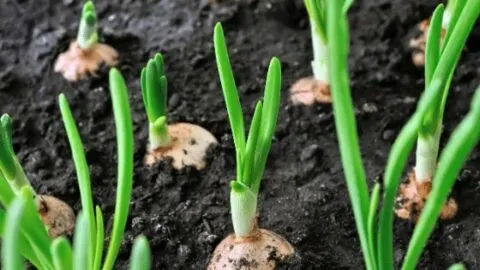Learn how to grow onions, from the right soil to watering and propagation. This care guide will leave no questions unanswered.
What are Onions?
Onion or Allium cepa, by its Latin name, is a cold-season crop. Onions come in a range of sizes and colors,
In the cooking domain, onion is crowned as the indispensable kitchen hero. Used in various dishes as a fundamental ingredient, onions are easy to grow, making them a popular vegetable for home gardens. That’s why we wrote this how-to-grow onions guide.
How to Grow Onions
The onion thrives in well-draining soil and needs watering every 7-10 days. It prefers full sun or bright indirect light and does well in temperatures between 50-80°F with 40-70% humidity. Fertilize once a month for optimal growth. You can propagate it using seeds or small bulbs known as sets.
Onion Growing Takeaways
| Species | Allium cepa |
|---|---|
| Synonyms | Onion, Onion, Wild onion, Liliaceae, Alliaceous plant, Hooker’s onion, Allium acuminatum |
| Family | Amaryllidaceae |
| Genus | Allium |
| Growth | Biennial, perennial |
| Height | 2.0ft / 0.6m |
| Width | 1.0ft / 0.3m |
| Soil | Well-draining soil mix. |
| Watering | Water every 7-10 days |
| Light | Full sun or bright indirect light. |
| Temperature | 50.0 – 80.0°F / 10.0 – 26.7°C |
| Humidity | 40.0 – 70.0% |
| Fertilizer | Once a month |
| Propogation | By seeds or sets (small bulbs) |
| Toxicity | Toxic to cats and dogs. Contain N-propyl disulfide. |
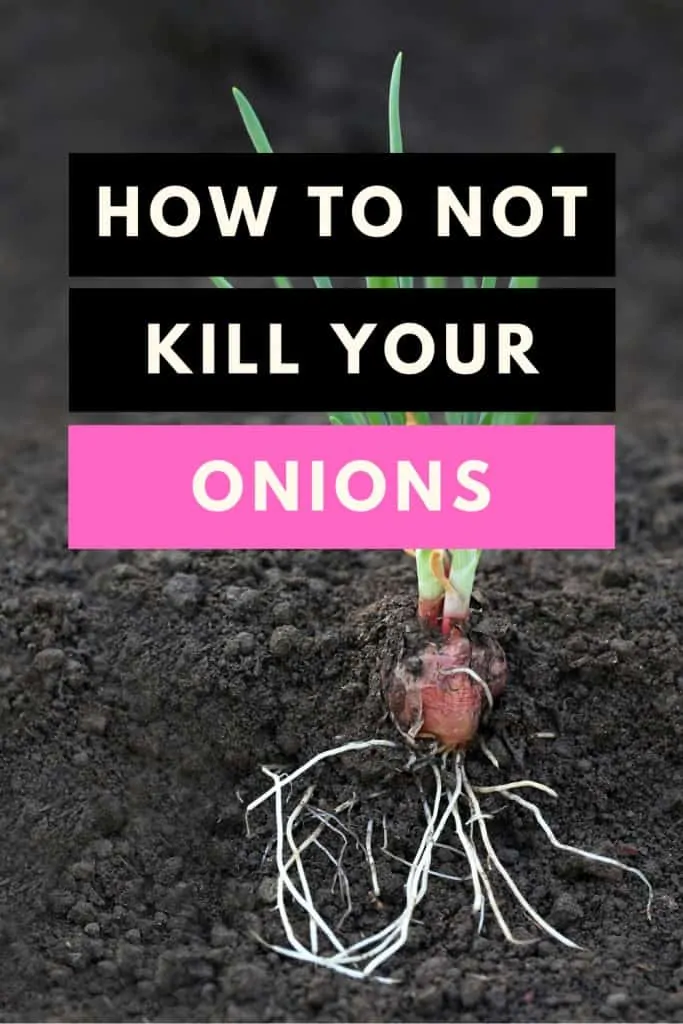
Table of Contents
Onion Planting Methods
1. Seeds
Planting onions with seeds opens up a wider variety, allowing you to choose the variety that best suits your region. For instance, in the northern regions, you can plant long-season onions in the spring, while short-season onions in the fall are suitable in the South.
Onion seeds live short and thus lose their viability when stored longer. Therefore start with fresh seeds each year. Start seeds indoors for about six weeks before transplanting to the garden. Peat moss is great soil to get started with seedlings in general. It is indispensable to know how to start from seeds when you want to know how to grow onions.
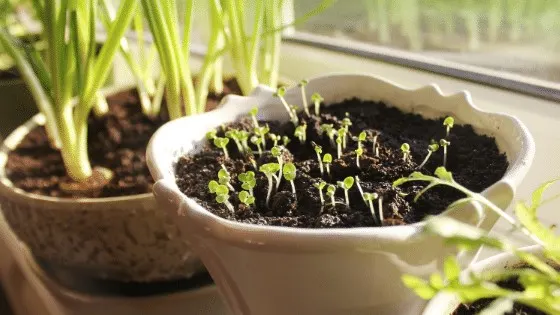
2. Transplants
Transplants are seedlings from the current growing season that are sold at nurseries in the form of bunches. The plus point of transplants is that they produce good-sized onion bulbs over a short period. However, they are more prone to diseases than the other two planting methods.
3. Onion Sets
Onion sets have little to offer in terms of variety but have a high success rate to get started with.
Among the three planting techniques, sets are the easiest way for beginners to grow onions. It is a good way to produce a lot of big onions for storage.
Plant bulbs into well-draining soil according to NC State Extension.
They are immature baby onion bulbs produced by thickly sown onion seeds from the past year. These immature bulbs are then planted to mature, producing a set of fully produced onions.
Onions sets are slightly towards the pricier side but give reliable results and require fewer efforts comparatively.
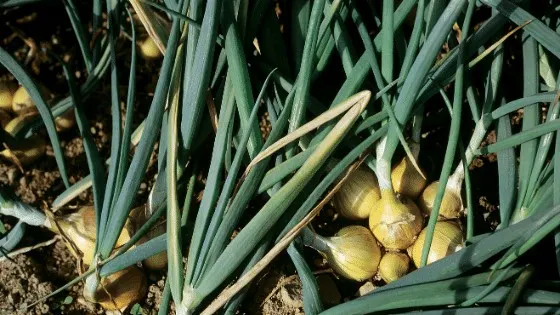
How to Grow Onions Guide
Where to Plant
A sun-loving location where onions won’t have to compete with other plants for sunlight is where you should start.
Next comes the soil.
Onions prefer a well-drained loam that is both loose and slightly sandier. A compact, clay-heavy soil tends to affect bulb development. Onions grow best under slightly acidic conditions; a soil pH ranging from 5.5 to 7.5 is considered suitable.
Before planting, gather a considerable amount of well-aged compost and rich manure and dump it with the loam in early spring. This helps improve soil fertility while promoting the healthy growth of onions. If your soil is already well-prepared, no additional fertilizers are required.
Onion plants need a constant supply of nutrients to produce big bulbs. Therefore, the soil should also have high concentrations of nitrogen but in a controlled amount, as excess nitrogen content halts the new growth from the center as bulbs form.
It is crucial to strictly practice crop rotation with the onion crop. It will not only aid in getting the most from the soil but also minimize any probability of soil diseases. Follow the basic rule of not planting crops from the same family in the same spot for consecutive years.
When to Plant
Cool-weather conditions are preferred by onions during the early stages of growth, making spring the perfect time of the year to plant them. However, onions are grown as a winter crop in areas with mild winters.
In general terms, onion tops require cool weather conditions to grow their tops while bulb development commences as the weather gets warmer. For each onion planting technique, the ideal planting time and duration vary.
Seeds – give you a much better variety, but to enjoy the perks, you must start earlier in the year for a longer growing season. The suggested time is around late January to mid-February. Sow seeds in your vegetable garden a month before the first frost date. You may sow them in pots, flats, or trays.
The best way is to sow four seeds per cell in a modular tray. You can move the tray from the heat bench around mid-March but keep it inside till early April, when you can begin hardening off.
Onion Sets – The ideal time to sow onion sets is between March and April. Generally, you should plant sets two to four weeks before your region’s average last frost date.
However, sowing from August to September is also considered normal. In areas that experience heavy winter rainfall, growing onions in raised soil beds is recommended because excessively damp soil tends to rot the onion sets.
Modular trays are often used to plant onion sets. These trays are then kept under an unheated greenhouse and planted out when the weather is suitable. After getting into how to grow onions, we also want to look into how to plant onions.
How to Plant Onions?
Plant onions at a distance of 2-6 inches and avoid burying them any deeper than an inch in the soil. For transplants, it is recommended that you plant them with a spacing of 4-5 inches in rows and individually at a distance of 12-18 inches. To facilitate the process of moisture retention, make sure to place straw mulch between each row of onion. This will also help in stifling the weeds.
Watering
Once the planting is completed, water the soil bed un you hit a depth of 6 inches (15 cm). Watering the onion plants deeply allows the soil to moisten well, essential in further nurturing the growth.
Be sure not to let the onions dry out during the period of growth. Not doing so will rot the bulbs. However, avoid overwatering them as excessively damp soil kills the onion sets, diminishing the harvest.
Cut back on watering bulb onions when their tops start to yellow to discourage rot.
Onions can be watered efficiently and regularly through soaker hoses and drip irrigation. You can also open small trenches between each row and fill water. This will ensure a constant water supply to the plantation, maintaining the desired moisture level.
Harvesting
As soon as the onion tops transition into a shade of yellow, bend them horizontally. This will allow the bulbs to mature. A few days later, when the tops turn brown, pull out the bulbs and expose them to dry under the sun. Take care not to damage the skins as this gives way to organisms that attack the onion flesh.
Once the outer skin dries thoroughly, clean off any dirt particles. Strictly refrain from cutting the stalks off your onions before the drying process completes, or they’ll suffer from severe rotting. Make sure that you pick out damaged onions or onions that show signs of decay, as these tend to affect healthy onions once stored together.
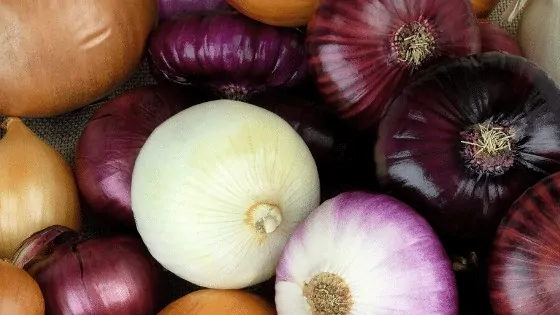
Onion Pests and Diseases
White Rot
White rot is the most serious of all fungal diseases found in onions. It causes yellow, wilting foliage and decays the roots to the bulb. It tends to reside in the soil for several years.
White rot is seen to cause the formation of fluffy white fungus on the surface of onion bulbs, and with time, it changes to black structures. There are no effective chemical treatments against this disease. However, crop rotation and soil sterilization are observed as a sound solution.
Onion Fly
Onion fly is common pests found in onion crops. It will occur in dry soils mostly during summers and attacks bulb onions, shallots, leeks, and salad onions. Crops that undergo onion fly attacks don’t develop properly, while older crops are killed.
To identify this fly, you can lift the plants and look for white maggots inside. You can remove the affected plants along with the soil to prevent the pest from spreading.
Eelworm
Eelworms are tiny, threadlike creatures residing in the soil, affecting the bulb and plant stem by distorting them. These minute organisms are not easy to spot. Plants can be severely damaged, and root crops adversely reduced as eelworms eat in the stems and disrupt the flow of nutrients upwards.
Eelworm attacks on onion plants can be avoided by following a regular crop rotation cycle.
FAQ
Is it important to fertilize the soil before planting onions?
Onions love relatively fertile soil with good drainage. In the case of heavy yet wet soil, you can add organic compost into the soil to activate its moisture-retaining properties. Avoid using fresh manure.
How do I get my onions to grow bigger?
Onion plants require loose soil and should be planted in the early months (January – March). Dig a shallow trench and add in compost and fertilizer for big onions. Plant the onions about an inch deep at a 4-5 inches distance (10-12.5 cm). However, if you are planting seeds, start them indoors for about six weeks before transplanting them into the garden. Onion seeds require a temperature of at least 50°F (10°C) for proper germination, allowing the bulbs to grow bigger.
How often should onion crops be watered?
A regular watering cycle is crucial to the development of onion bulbs. When you plant the onion, you must water the soil, allowing the roots to grow faster. This will facilitate the nutrient flow to the plant. However, do not overwater the soil, as roots rot when drowned in damp soil.
Why has my onion crop harvested small onions?
Small onions result from growing the wrong onion type in your region. Before you plant onion seeds, make sure to see which type suits your area’s climate conditions. Seeds for short-day onions should be planted in the fall, while long-day onions are grown from onion sets and seedlings.
What is the best fertilizer for onions?
For onions to grow under controlled conditions, a steady nitrogen supply is essential. Large bulbs form only when the nitrogen content in the soil is at the desired level. You should fertilize your soil at least twice a month with ½ cup of nitrogen-based fertilizer. Check the soil pH to help you pick the right fertilizer.
How long should I leave onions in the ground?
Leave the bulbs in the ground for a minimum of 10 days to a maximum of two weeks. This duration will allow them to mature completely. Leaving them in the ground for more than two weeks after the top dies will increase the risk of attacks from organisms, causing the onion flesh to rot.
The Last Potato
From salads to gravy, from soups to savory pie, onion is a staple ingredient in the kitchen pantry. Although it is affordable at grocery stores, onions can also be easily grown in your vegetable garden with minimal effort. Using onion seeds, you can plant a wider range of onions (red onions, shallots, chives, and Egyptian onions) in your garden only.

Daniel has been a plant enthusiast for over 20 years. He owns hundreds of houseplants and prepares for the chili growing seasons yearly with great anticipation. His favorite plants are plant species in the Araceae family, such as Monstera, Philodendron, and Anthurium. He also loves gardening and is growing hot peppers, tomatoes, and many more vegetables.

